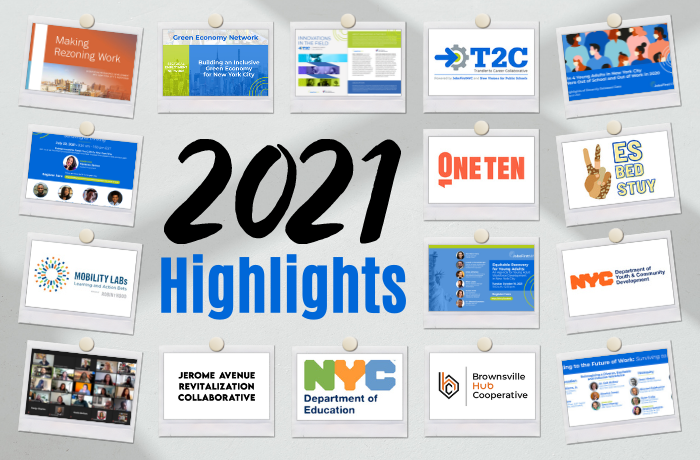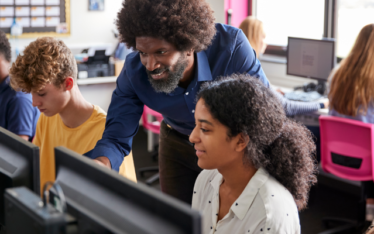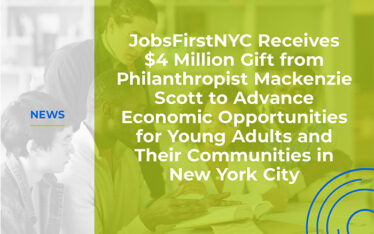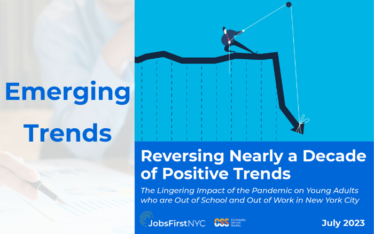Last year challenged our north star to reduce the number of young people who are out of school, out of work and improve economic opportunities for them and the communities where they live. In 2021, the COVID-19 pandemic continued to impact the lives of young people, hitting people in historically economically challenged communities especially hard, above all by impeding their ability to secure sustainable livelihoods. Indeed, last year, about 184,000 New Yorkers aged 18–24 were out of school and out of work (almost 27% of this age group), representing an 80% increase from the previous year. This brought us nearly full circle to where we were in 2006, when a similar crisis facing this population provided the impetus for JobsFirstNYC’s creation.
Against this backdrop, we worked diligently with our partners to address the repercussions of COVID-19 and to ensure that young adults would not be left behind in the city’s economic recovery. Below are highlights of our notable headway in advancing economic opportunities and economic mobility for young adults in 2021:
1. Advancing Community Solutions to Improve Place-Based Economics
Six of our place-based partnerships built their public and digital presence and reconnected with their communities during another year of pandemic stress. In particular, they focused on how to provide resources, services, and programs to community residents in a way that was equitable, culturally relevant, and responsive to the ever-changing public health safety measures that forced many nonprofits to operate virtually.
We successfully launched three new place-based partnerships: the Brownsville HUB Cooperative (Brooklyn), which uses a community-driven approach to advance economic mobility; the Jerome Avenue Revitalization Collaborative (Bronx), which responds to local hiring needs, offers B2B services, and provides jobs, education, and training; and YES Bed Stuy (Brooklyn), which builds stronger pathways to education and employment services for young adults, with a heavy emphasis on youth voice. These initiatives bring together a range of organizations to increase employment opportunities and create localized solutions that respond to the unique needs of neighborhoods with high numbers of young people who are out of school and out of work.
2. Improving Education Pathways to Upward Mobility
We made great strides in embedding career pathways in the New York City high school system to stem the flow of young adults entering the out-of-school, out-of-work population. Our Transfer 2 Career Collaborative (T2C), in its fourth year, shared early results showing that in its first two years, student enrollment in postsecondary training and education increased by 50% and participation rates in T2C programming grew from 26.9% to 49.7% of all students.
We also drew on the innovative practices learned from T2C to partner with the New York City Department of Education to support over 500 high schools through Advising for Career Pathways: An Innovative Approach to Postsecondary Education and Career Planning. This effort provides high school staff with a Postsecondary Planning Practitioner Credential to help them better prepare students to make informed, strong postsecondary choices.
Meanwhile, the JobsFirstNYC-led Bronx Opportunity Network focused its efforts on bolstering college enrollment and success among low-income students; helping students navigate the process of reentering classrooms and campuses after two years of remote learning; and building stronger bridges between two- and four-year colleges through the Bronx Transfer Affinity Group.
3. Advancing Workforce Equity
In 2021, building on effective approaches to improve outcomes for workers and employers, we expanded our signature Young Adult Sectoral Employment Project (YASEP), to design citywide sector networks that meet the dynamic needs of employers, jobseekers, and workforce training organizations. The goals of this approach are to advance high-quality skills training, strengthen collective mechanisms for workforce development organizations to negotiate with employers, customize training to meet targeted hiring demands, and increase employment opportunities and wages for jobseekers. To implement this approach, we launched the Green Economy Network with co-lead partners Green City Force, The HOPE Program and Nontraditional Employment for Women. JobsFirstNYC is planning for tech, healthcare and food service/hospitality sector networks.
To further increase access to higher-wage jobs and economic mobility, we partnered with the OneTen coalition as the New York City community development lead. OneTen is a national coalition of industry leaders committed to connecting one million Black Americans to family-sustaining careers by 2030, working with leaders in industry to take a skills-first approach to hiring and creating a more equitable and inclusive workforce. As the community development lead, we serve as OneTen’s local support and play an active leadership, facilitation, and project management role.
4. Analyzing the Challenges and Opportunities Facing Young Adults, Their Communities, and Workforce Development Practitioners
Our policy, research, and learning work focused on elevating the voices from practitioners in the field, defining the challenges of our constituents, and uncovering opportunities for effective, sustainable solutions. We published a data-focused brief entitled 1 in 4 Young Adults in New York City Were Out of School and Out of Work in 2020. As the brief points out, after declining for years, the rate of out-of-school and out-of-work 18- to 24-year-old New Yorkers hit a decade high of 183,734 in 2020, which represents an 80% increase from 2019. We published Equitable Recovery for Young Adults, a report calling for a $770 million investment in young adult workforce development and highlighting the changes needed to quickly connect young adults to jobs and effectively prepare them for the future of work.
Through our partnership Invest in Skills NY we published Follow the Money, a paper documenting how much New York City is invested—literally—in workforce development and what we know about the operations and results of these investments. The paper includes a set of recommendations and a roadmap for incoming legislators wishing to understand the landscape of workforce development dollars in city government. We also published Making Rezoning Work: Integrating Workforce Development into New York City’s Rezonings in collaboration with the Center for an Urban Future, which demonstrates the need to integrate a comprehensive workforce development strategy into future rezonings.
In response to the country’s tumultuous political climate, we explored ways to integrate diversity, equity, and inclusion into all aspects of our lives, particularly our workspaces. In the wake of the 2021 Insurrection, we called for Americans to stand up for a democracy that gives an equal voice to every American and explained Why We Continue to Celebrate Black History Month—so that young Americans can continue to learn about the depth of Black Americans’ contributions to American society and acknowledge Black history as American history.
5. Lifting up Young Adult Voices in Our Communities
We facilitated the sixth annual Adapting to the Future of Work convening, where more than 700 young adults and 300 business professionals engaged in a lively two-day conversation to examine disparities in education, training and employment, and to present new solutions to the complex workforce issues that the COVID-19 pandemic has exacerbated. New to this year’s convening was the launch of the first “My City, My Community” competition, in which young adults pitched entrepreneurial ideas on how to advance social justice and make New York City better. The top three prizes went to OpportuniTeens (an initiative run by Cynthia Lei and Crystal Liang that provides students with information regarding college and career readiness opportunities through social media and a student-friendly website); Erasing EWaste (an initiative led by Justin Shnayder and Alexandra Shakhnazarov to make e-waste recycling services more accessible to New Yorkers through education, community events, and crowdsourced data); and the Teens Program (an immersive long-term program designed by Victoria Chang to destigmatize mental illness in K–12 education).
6. Building Partnerships in the Fight for Equity, Access, and Economic Mobility
As an intermediary, our greatest opportunity to change systems lies in our ability to build strong partnerships focused on creating more and better opportunities for communities with stagnant economic growth and limited economic mobility. In 2021, we partnered with Robin Hood Mobility LABs to reimagine how philanthropy can support community-centered solutions to economic development; the New York City Department of Education to reimagine career pathways for students; the City Council of New York to strengthen economic opportunities in East Harlem, New York; and the KELLEY DRYE’S Task Force on Racial Equity Campaign to tackle the broad range of substantive areas affected by racial inequality, including education relating to the legacy of slavery and its aftermath and economic opportunity.
7. Congratulating Our Partners Working to Define New York City Policy Issues
In a time when political representation has taken on additional importance and where there is an urgent need for local community leaders to have a voice in shaping policies, two leaders of our place-based partnerships joined a new slate of legislators at the City Council of New York: Youth WINS member Kamillah Hanks was elected to District 49 in Staten Island, and JARC member Pierina Sanchez was elected to District 14 in the Bronx. Further, Eric Adams, a long-time advocate of young people’s well-being, was elected New York City mayor. We supported Adams’ transition team by providing the new administration with an actionable agenda for strengthening the city’s young adult workforce development system.
8. Building Our Own Capacity
As we advanced our organizational mission, we expanded our staff by over 30% to include Kendrick Armstrong, Learning Fellow; Stephany Garcia, Manager of Partnership and Community Engagement; Dave Scott, Manager of Work Solutions; and Kristin Wilson, Learning Fellow. We also added new board members with proven experience in change management: Sunil B. Gupta, Vice President, for the Division of Adult Continuing Education & Workforce Development at LaGuardia Community College; Clive Harrow, Vice President, M&A Operations at Platinum Equity; Annette O’Hanlon, Chief Corporate Responsibility and Diversity Officer at S&P Global; and Andre D. White, Executive Director and CEO of Phipps Neighborhoods.
Meeting the Challenges of 2022
New York City needs to act swiftly to reduce the number of 18- to 24-year-olds who are out of school and out of work; to connect these young adults to training, education, and work opportunities; to advance them along educational and career pathways; and to provide early exposure to career development and workforce opportunities throughout the public education system. Meeting the challenges of 2022 will require all of us to lean in and find equitable solutions.
In 2022, we will double down on our efforts to ensure that the city invests $770 million in young adult workforce development to support the six key recommendations contained in our report Equitable Recovery for Young Adults:
|
This funding would expand investment in bridge programming, sectoral employment skills training, subsidized jobs, high school degree attainment and career preparation, and capacity building and system enhancements in workforce development.
We thank all of our supporters, partners, and colleagues for making this important work possible. There is still so much to do, and we look forward to meeting the challenges of 2022.





